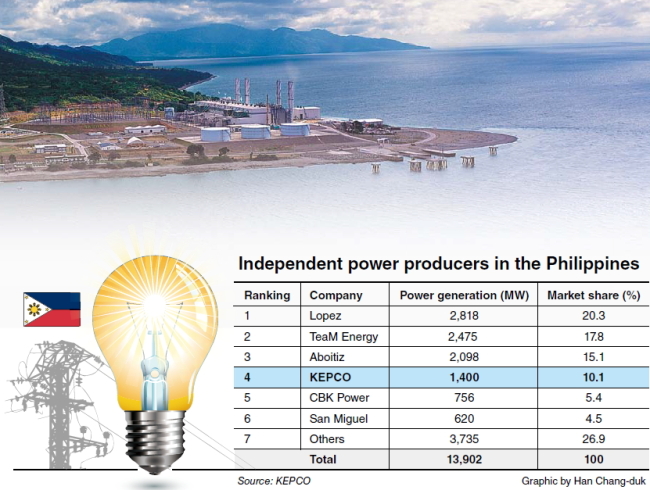This is the first in a series of case studies on the nation’s leading state-run companies which have made success stories overseas. ―Ed.
The state-run Korea Electric Power Corp., or KEPCO, the nation’s sole electricity transmission and distribution company, is not only lighting up Korean households, offices and plants. It entered the overseas electricity generation market in 1996 when it won an order from the Philippine government for the construction of a 1,200-megawatt combined-cycle power plant in Ilijan. It was the largest natural gas-based power plant in the Philippines.
“It was a kind of miracle KEPCO won the order without a track record by beating seven international power producers,” said Kim Ik-rae from KEPCO’s Overseas Project Management Department, who was involved in the Ilijan project.
“The winning strategy in fierce competition was to cut costs for the plant construction as much as possible, closely working with local construction firms while maintaining the quality of the plant,” he said.

KEPCO runs 11 overseas projects in power generation as of 2012, 19 in power transmission and distribution and 11 in energy resource development.
In 2011, sales from overseas businesses took up 5.6 percent of the 43.2 trillion won ($40 billion) in total sales.
In the electricity generation and distribution sector, KEPCO began eyeing the overseas market in the mid-1990s as the nation’s industries matured and domestic demand for power began to fall.
KEPCO’s overseas expansion drive in the electricity sector, however, was dented by the financial crisis in late 1997, though it recovered quickly from the late 2000s.
Among overseas projects, investments in the Philippines have been recognized as the greatest success story.
The Ilijan project, KEPCO’s first project in the Philippines, is based on the build-own-transfer contract. Under the BOT contract, KEPCO completed construction of the plant in 2002 and has run the power plant since then. After 20 years of ownership, KEPCO must hand over the plant to the Philippine government in 2022.
“We have already paid the cost of initial investment back to creditors and reaped $720 billion (667 million won) as of 2011 by distributing electricity generated by the Ilijan power plant,” Kim said.
The nation’s utility giant continued to explore new projects in the Philippines and it constructed a 200-megawatt power plant in Naga, Cebu, in 2011.
“The KEPCO plant lights up about 27 percent of households in Cebu,” the KEPCO official said.
The power plant is based on a build-operate-own, or BOO, contract, thus making it possible for KEPCO to maintain its ownership after 25 years of operation.
With the power generated from KEPCO plants in Ilijan and Cebu, KEPCO is responsible for about 10 percent of the total power generated in the Philippines. KEPCO has become the fourth-largest independent power provider in the Philippines, the company said in a statement.
As domestic sales of KEPCO have been in doldrums due in part to limits on increasing electricity prices, industry watchers forecast KEPCO would drive overseas expansion. The utility giant set the goal of expanding its sales overseas to 30 percent of total sales by 2020. At the end of 2012, about 574 of its 19,225 employees in Korea work for the overseas business-related departments, the company said.
By Seo Jee-yeon (
jyseo@heraldcorp.com)








